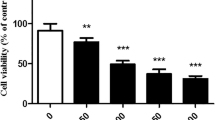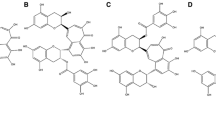Abstract
Acrylamide (ACR) is a potent neurotoxic in human and animal models. In this study, the effect of crocin, main constituent of Crocus sativus L. (Saffron) on ACR-induced cytotoxicity was evaluated using PC12 cells as a suitable in vitro model. The exposure of PC12 cells to ACR reduced cell viability, increased DNA fragmented cells and phosphatidylserine exposure, and elevated Bax/Bcl-2 ratio. Results showed that ACR increased intracellular reactive oxygen species (ROS) in cells and ROS played an important role in ACR cytotoxicity. The pretreatment of cells with 10–50 μM crocin before ACR treatment significantly attenuated ACR cytotoxicity in a dose-dependent manner. Crocin inhibited the downregulation of Bcl-2 and the upregulation of Bax and decreased apoptosis in treated cells. Also, crocin inhibited ROS generation in cells exposed to ACR. In conclusion, our results indicated that pretreatment with crocin protected cells from ACR-induced apoptosis partly by inhibition of intracellular ROS production.






Similar content being viewed by others
References
Abdullaev FI, Espinosa-Aguirre JJ (2004) Biomedical properties of saffron and its potential use in cancer therapy and chemoprevention trials. Cancer Detect Prev 28(6):426–432
Assimopoulou AN, Sinakos Z, Papageorgiou VP (2005) Radical scavenging activity of Crocus sativus L. extract and its bioactive constituents. Phytother Res 19(11):997–1000
Cao J, Liu Y, Jia L, Jiang LP, Geng CY, Yao XF, Kong Y, Jiang BN, Zhong LF (2008) Curcumin attenuates acrylamide-induced cytotoxicity and genotoxicity in HepG2 cells by ROS scavenging. J Agric Food Chem 56(24):12059–12063
Chen JH, KY Wu, Chiu IM, Tsou TC, Chou CC (2009) Acrylamide-induced astrogliotic and apoptotic responses in human astrocytoma cells. Toxicol In Vitro 23(5):855–861
Claus A, Carle R, Schieber A (2008) Acrylamide in cereal products: a review. J Cereal Sci 47(2):118–133
De Lima TM, Amarante-Mendes GP, Curi R (2007) Docosahexaenoic acid enhances the toxic effect of imatinib on Bcr-Abl expressing HL-60 cells. Toxicol In Vitro 21(8):1678–1685
Elmore S (2007) Apoptosis: a review of programmed cell death. Toxicol Pathol 35(4):495–516
Frenzel A, Grespi F, Chmelewskij W, Villunger A (2009) Bcl2 family proteins in carcinogenesis and the treatment of cancer. Apoptosis 14(4):584–596
Gilgun-Sherki Y, Melamed E, Offen D (2001) Oxidative stress induced-neurodegenerative diseases: the need for antioxidants that penetrate the blood brain barrier. Neuropharmacology 40(8):959–975
Hadizadeh F, Mohajeri S, Seifi M (2010) Extraction and purification of crocin from saffron stigmas employing a simple and efficient crystallization method. Pak J Biol Sci 13:691–698
Hariri AT, Moallem SA, Mahmoudi M, Memar B, Hosseinzadeh H (2010) Sub-acute effects of diazinon on biochemical indices and specific biomarkers in rats: protective effects of crocin and safranal. Food Chem Toxicol 48(10):2803–2808
Hariri AT, Moallem SA, Mahmoudi M, Hosseinzadeh H (2011) The effect of crocin and safranal, constituents of saffron, against subacute effect of diazinon on hematological and genotoxicity indices in rats. Phytomedicine 18(6):499–504
Hosseinzadeh H, Ziaei T (2006) Effects of Crocus sativus stigma extract and its constituents, crocin and safranal, on intact memory and scopolamine-induced learning deficits in rats performing the Morris water maze task. J Med Plants 5(19):40–50
Hosseinzadeh H, Karimi G, Niapoor M (2004) Antidepressant effects of Crocus sativus stigma extracts and its constituents, crocin and safranal, in mice. J Med Plants 3(11):48–58
Hosseinzadeh H, Sadeghnia HR, Ziaee T, Danaee A (2005) Protective effect of aqueous saffron extract (Crocus sativus L.) and crocin, its active constituent, on renal ischemia-reperfusion-induced oxidative damage in rats. J Pharm Pharm Sci 8(3):387–393
Hosseinzadeh H, Modaghegh MH, Saffari Z (2009) Crocus sativus L. (saffron) extract and its active constituents (crocin and safranal) on ischemia-reperfusion in rat skeletal muscle. Evid Based Complement Alternat Med 6(3):343–350
Hosseinzadeh H, Shamsaie F, Mehri S (2010) Antioxidant activity of aqueous and ethanolic extracts of Crocus sativus L. stigma and its bioactive constituents crocin and safranal. Pharmacogn Mag 5(20):419–424
Kannan K, Jain SK (2000) Oxidative stress and apoptosis. Pathophysiology 7(3):153–163
Li Y, Shi W, Li Y, Zhou Y, Hu X, Song C, Ma H, Wang C, Li Y (2008) Neuroprotective effects of chlorogenic acid against apoptosis of PC12 cells induced by methylmercury. Environ Toxicol Pharmacol 26(1):13–21
LoPachin RM (2004) The changing view of acrylamide neurotoxicity. Neurotoxicology 25(4):617–630
LoPachin RM (2005) Acrylamide neurotoxicity: neurological, morhological and molecular endpoints in animal models. Adv Exp Med Biol 561:21–37
Mannaa F, Abdel-Wahhab MA, Ahmed HH, Park MH (2006) Protective role of Panax ginseng extract standardized with ginsenoside Rg3 against acrylamide-induced neurotoxicity in rats. J Appl Toxicol 26(3):198–206
Mousavi SH, Tavakkol-Afshari J, Brook A, Jafari-Anarkooli I (2009a) Direct toxicity of Rose Bengal in MCF-7 cell line: role of apoptosis. Food Chem Toxicol 47(4):855–859
Mousavi SH, Tavakkol-Afshari J, Brook A, Jafari-Anarkooli I (2009b) Role of caspases and Bax protein in saffron-induced apoptosis in MCF-7 cells. Food Chem Toxicol 47(8):1909–1913
Mousavi SH, Tayarani NZ, Parsaee H (2010) Protective effect of saffron extract and crocin on reactive oxygen species-mediated high glucose-induced toxicity in PC12 cells. Cell Mol Neurobiol 30(2):185–191
Ochiai T, Ohno S, Soeda S, Tanaka H, Shoyama Y, Shimeno H (2004a) Crocin prevents the death of rat pheochromyctoma (PC-12) cells by its antioxidant effects stronger than those of α-tocopherol. Neurosci Lett 362(1):61–64
Ochiai T, Soeda S, Ohno S, Tanaka H, Shoyama Y, Shimeno H (2004b) Crocin prevents the death of PC-12 cells through sphingomyelinase-ceramide signaling by increasing glutathione synthesis. Neurochem Int 44(5):321–330
Ochiai T, Shimeno H, Ki Mishima, Iwasaki K, Fujiwara M, Tanaka H, Shoyama Y, Toda A, Eyanagi R, Soeda S (2007) Protective effects of carotenoids from saffron on neuronal injury in vitro and in vivo. Biochim Biophys Acta 1770(4):578–584
Okuno T, Matsuoka M, Sumizawa T, Igisu H (2006) Involvement of the extracellular signal-regulated protein kinase pathway in phosphorylation of p53 protein and exerting cytotoxicity in human neuroblastoma cells (SH-SY5Y) exposed to acrylamide. Arch Toxicol 80(3):146–153
Oltvai ZN, Milliman CL, Korsmeyer SJ (1993) Bcl-2 heterodimerizes in vivo with a conserved homolog, Bax, that accelerates programmed cell death. Cell 74(4):609–619
Rios JL, Recio MC, Giner RM, Manez S (1996) An update review of saffron and its active constituents. Phytother Res 10(3):189–193
Satpute RM, Hariharakrishnan J, Bhattacharya R (2008) Alpha-ketoglutarate and N-acetyl cysteine protect PC12 cells from cyanide-induced cytotoxicity and altered energy metabolism. Neurotoxicology 29(1):170–178
Scorrano L, Korsmeyer SJ (2003) Mechanisms of cytochrome c release by proapoptotic BCL-2 family members. Biochem Biophys Res Commun 304(3):437–444
Shipp A, Lawrence G, Gentry R, McDonald T, Bartow H, Bounds J, Macdonald N, Clewell H, Allen B, Van Landingham C (2006) Acrylamide: review of toxicity data and dose-response analyses for cancer and noncancer effects. Crit Rev Toxicol 36(6):481–608
Soeda S, Ochiai T, Paopong L, Tanaka H, Shoyama Y, Shimeno H (2001) Crocin suppresses tumor necrosis factor-alpha-induced cell death of neuronally differentiated PC-12 cells. Life Sci 9(24):2887–2898
Soeda S, Ochiai T, Shimeno H, Saito H, Abe K, Tanaka H, Shoyama Y (2007) Pharmacological activities of crocin in saffron. J Nat Med 61(2):102–111
Sumizawa T, Igisu H (2007) Apoptosis induced by acrylamide in SH-SY5Y cells. Arch Toxicol 81(4):279–282
Sumizawa T, Igisu H (2009) Suppression of acrylamide toxicity by carboxyfullerene in human neuroblastoma cells in vitro. Arch Toxicol 83(9):817–824
Xu G, Gong Z, Yu W, Gao L, He S, Qian Z (2007) Increased expression ratio of bcl-2/bax is associated with crocin-mediated apoptosis in bovine aortic endothelial cells. Basic Clin Pharmacol Toxicol 100(1):31–35
Yousef MI, El-Demerdash FM (2006) Acrylamide-induced oxidative stress and biochemical perturbations in rats. Toxicology 219(1–3):133–141
Zeng KW, Wang XM, Ko H, Yang HO (2010) Neuroprotective effect of modified Wu-Zi-Yan-Zong granule, a traditional Chinese herbal medicine, on CoCl2-induced PC12 cells. J Ethnopharmacol 130(1):13–18
Zhu YJ, Zeng T, Zhu YB, Yu SF, Wang QS, Zhang LP, Guo X, Xie KQ (2008) Effects of acrylamide on the nervous tissue antioxidant system and sciatic nerve electrophysiology in the rat. Neurochem Res 33(11):2310–2317
Acknowledgments
The authors are thankful to the Vice Chancellor of Research, Mashhad University of Medical Sciences for financial support. The results described in this article are part of a Ph.D. thesis.
Author information
Authors and Affiliations
Corresponding author
Rights and permissions
About this article
Cite this article
Mehri, S., Abnous, K., Mousavi, S.H. et al. Neuroprotective Effect of Crocin on Acrylamide-induced Cytotoxicity in PC12 cells. Cell Mol Neurobiol 32, 227–235 (2012). https://doi.org/10.1007/s10571-011-9752-8
Received:
Accepted:
Published:
Issue Date:
DOI: https://doi.org/10.1007/s10571-011-9752-8




